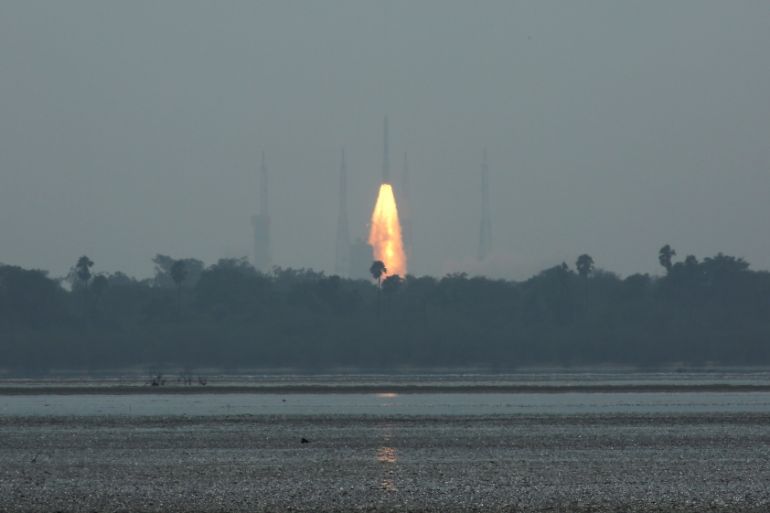India space launch: One rocket, 29 satellites, three orbits
The Indian space agency places domestic and foreign satellites in three orbits on a single flight.

India has successfully placed a domestic intelligence-gathering satellite as well as smaller satellites from other countries in three different orbits on a single flight, a first for the nation and a low-cost option that could burnish its reputation for pioneering affordable options in space.
India’s 436-kilogramme EMISAT intelligence satellite was launched on Monday along with 28 foreign ones from the Sriharikota launch pad in southeastern state of Andhra Pradesh, and was now orbiting 749 kilometres about the Earth, the state-run Indian Space Research Organisation (ISRO) said.
Keep reading
list of 4 itemsPhotos: Mexico, US, Canada mesmerised by rare total solar eclipse
Moment total solar eclipse occurs in North America
Millions across North America await total solar eclipse
Twenty-four of the small satellites were from the United States, two from Lithuania and one each from Spain and Switzerland, the space agency said.
“This particular mission is very special for ISRO,” Chairman K Sivan said after the launch.
“For the first time, the PSLV is carrying out three orbital missions in a single flight,” he said in a speech, referring to the Polar Satellite Launch Vehicle family of rockets.
#WATCH Sriharikota: ISRO's #PSLVC45 lifts off from Satish Dhawan Space Centre, carrying EMISAT & 28 customer satellites on board. #AndhraPradesh pic.twitter.com/iQIcl7hBIH
— ANI (@ANI) April 1, 2019
Defence analyst Brahma Chellaney said the Low Earth Orbit EMISAT would serve as a military reconnaissance and intelligence satellite.
It will monitor and give locations for enemy radar sites, local broadcaster NDTV reported.
Prime Minister Narendra Modi congratulated the agency on the launch and said his government was working on raising citizens’ interest in science and their respect for scientists.
‘Fourth space power’
For the first time, the public was invited to view the launch from the space centre.
It came days after India conducted an anti-satellite missile test and claimed to become the fourth “space power” possessing anti-satellite weapon capability after China, Russia and the US.
Among the satellites in Monday’s launch are 20 earth-imaging satellites of Planet Labs Inc, a private satellite operator based in San Francisco.
Two of the satellites, one from Lithuania and another from Switzerland, will be used for the “Internet of Things”, or connecting physical devices to the web, the agency added.
🇮🇳 #ISROMissions 🇮🇳
The photo and tech teams at SDSC, SHAR in Sriharikota captured these two images from today's #PSLVC45 launch. pic.twitter.com/vUZLHbKGcR
— ISRO (@isro) April 1, 2019
Sivan, who previously told the media the “three-in-one” launch would help cut costs, said the agency aimed to complete 30 more missions this year, including India’s second lunar exploration programme known as the Chandrayaan-2.
Critics say India’s developing technology is another worrying step towards the militarisation of space.
Last year, India said it expected to spend less than 100 billion rupees ($1.4bn) on its first manned space mission to be launched by 2022, suggesting it is likely to be cheaper than similar projects by the US and China.
India’s 2014 launch of an unmanned Mars mission cost $74m, just a fraction of the $671m spent by US space agency NASA on its MAVEN Mars mission.